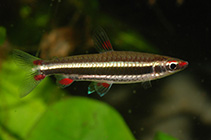| Family: |
Lebiasinidae (Pencilfishes), subfamily: Pyrrhulininae |
| Max. size: |
3.28 cm SL (male/unsexed) |
| Environment: |
benthopelagic; freshwater |
| Distribution: |
South America: Venezuela. |
| Diagnosis: |
This species is similar to Nannostomus trifasciatus Steindachner, 1876 and N. erythrurus (Eigenmann, 1909), but it can be clearly distinguished by the following features of its coloration and pattern: exhibits sexual dichromatism, with males having ruby spots on the dorsal, anal, ventral fins and on the base of the caudal lobes while females having hyaline fins (vs. sexual dischormatism not developed in N. trifasciatus and N. erythrurus, with males and females having red spots on the dorsal, anal and vertral fins and on the base of the caudal lobes); primary horizontal stripe is relatively wide and somewhat lower, covering the lower part of the peduncle and ends on the caudal peduncle or is only a little bit on the caudal fin (vs. narrower, somewhat lower, covering the lower part of the peduncle and extends only onto the base (about 1/5th) of the three first lower caudal rays in N. trifasciatus; narrower and somewhat higher primary horizontal stripe not entirely covering the inferior part of the peduncle and extending onto the basal third or half of the three first lower caudal rays in N. erythrurus); and secondary horizontal stripe is relatively weakly developed, lower situated and extending to the end of the peduncle (vs. strongly developed, lower situated and extends to the end of the caudal peduncle in N. trifasciatus; somewhat higher, extending to the base of the adipose fin in N. erythrurus. N. nigrotaeniatus and N. erythrurus have no red stripe between primary and secondary horizontal band (vs. having one in N. trifasciatus, but this is only visible in living specimens) (Ref. 94659). |
| Biology: |
|
| IUCN Red List Status: |
Data deficient (DD); Date assessed: 16 November 2020 Ref. (130435)
|
| Threat to humans: |
harmless |
| Country info: |
|
Source and more info: www.fishbase.org. For personal, classroom, and other internal use only. Not for publication.

